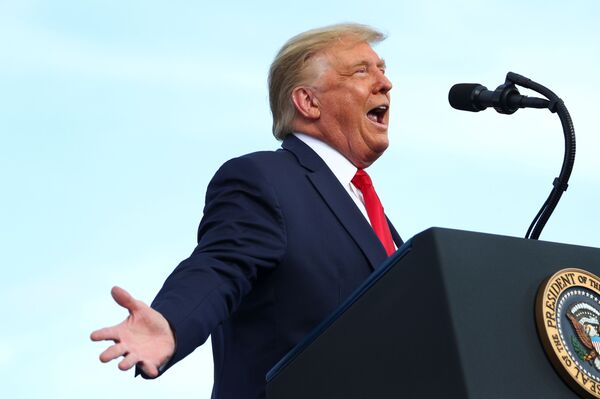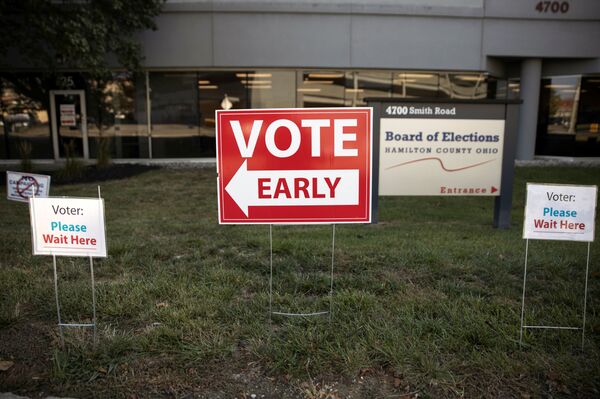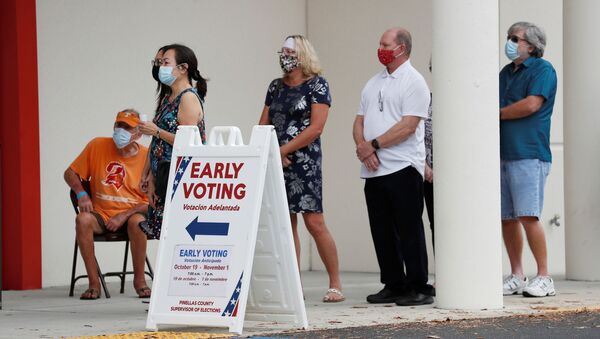Just slightly over a week ahead of the US presidential election, a record-breaking turnout of early voters is being registered across the entire country.
According to the independent US Election Project, run by the University of Florida, as of Sunday more than 59 million people had voted, surpassing all 2016 early ballots.
While the Democrats, who strongly encouraged early voting, have been leading the initial balloting, Republicans are narrowing the gap, with GOP voters showing up for early in-person voting.
Here's what you need to know today:
Texas Leads in Early Vote
Texas is one of the states that has been showing an unprecedented level of early voting.
According to the Election Project, on Sunday 80 percent of the early 2016 vote had already turned out.

Michael McDonald, a political science professor at the University of Florida who administers the Election Project, tweeted to wonder just how far Texas turnout will outpace that of 2016.
Second TX #earlyvote update of the day lifts the state above 80% of its 2016 total turnout. Folks, Texas still has in-person early voting until Friday, plus Election Day. No doubt Texas turnout will be above 2016. Question is, how much? https://t.co/s8K2xFDeSA
— Michael McDonald (@ElectProject) October 25, 2020
More than 7.1 million ballots have already been received in the state, according to the US Elections Project website.
A new poll by the Dallas Morning News and the University of Texas at Tyler shows Democratic hopeful Joe Biden surging ahead among likely voters, with 48 percent to Donald Trump’s 45 percent.
The long-time red state of Texas hasn't voted for a Democratic presidential candidate since choosing Jimmy Carter over Republican Gerald Ford in 1976.
In 2016 Donald Trump claimed the state's 38 electoral votes by nine points over Hillary Clinton.
The current early voting data already represents 80 percent of the total voting in the 2016 election, writes USA Today.
Gap Narrows in Florida
In Florida, where Donald Trump won by a little over one percentage point in 2016, the Democrats continue to maintain an advantage in pre-election turnout, according to Catalist data. However, as more voters participate in early voting across the state, the gap is believed to be narrowing.
Democrats now account for 43 percent of the early votes, while Republicans account for 36 percent, reports CNN.

The outlet's polling conducted by SSRS suggests that about 35 percent of likely voters in Florida acknowledged they have already cast their ballots, with 71 per cent reportedly backing Joe Biden and 27 percent backing Trump.
Fifty-six per cent of those who haven’t yet cast a ballot say they back Trump, and 40 percent claim to support Biden.
Younger Voters cast More Ballots
In an interesting trend, younger voters (age 18-29) are shown as casting more ballots and constituting a greater share of the pre-Election Day vote than at the same time four years ago in key battleground states, according to data from Catalist, a company that provides data, analytics and other services.
While voters below the age of 30 have seen a surge in their share of the early vote compared to 2016 at this point in time, voters age 30 and above continue to comprise the majority of the early voters. Their share is believed to have lessened slightly as compared to 2016.
Early voting among those 65 and older has shrunk as a proportion of total early voting.
‘New Voters’ on Uptick
Early voting data suggests a surge in the number of new or infrequent voters who have already voted. Thus, 25 percent of the total votes cast, according to an AP analysis of data from the political data firm L2, are from people younger than the typical voter, with similar shares of them registering Democratic and Republican up until now.

The ‘new’ voters are believed to have contributed to larger turnouts in states such as Georgia, where 26.3 per cent of the people who’ve voted are new or infrequent voters, and Texas, with 30.5 percent new or infrequent voters.
It is these voters that have led some analysts to predict that over 150 million total votes will be cast in the US elections, with the potential to represent the highest turnout since 1908.




